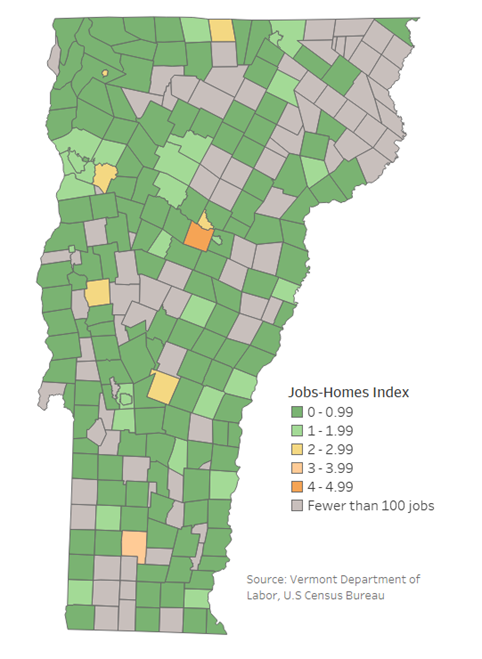Towns with sufficient homes to house the employees that work there are more likely to make inroads against climate change and the housing affordability crisis. According to data published this week by the Vermont Housing Data website, the top Vermont town with over 10,000 workplaces to strike this balance is Essex. For every 100 homes in Essex, the town has 112 jobs.

The Jobs-Homes Index compares the number of jobs in an area with the number of occupied (non-seasonal) homes there. Experts suggest that an ideal market would have a ratio of 1.5. A ratio higher than 1.5 indicates that the community may not have enough homes to meet the demands of its workforce. Homes with lower ratios than 1.0 tend to serve as ‘bedroom communities’ for adjacent job centers.
Vermont towns with over 10,000 jobs
| Town/city | Jobs | Jobs-Homes Index | Average annual housing growth |
|---|---|---|---|
| Burlington | 33,154 | 1.9 | 0.8% |
| South Burlington | 16,701 | 1.8 | 1.4% |
| Rutland City | 12,595 | 1.7 | -0.1% |
| Williston | 11,629 | 2.7 | 2.3% |
| Essex | 10,426 | 1.1 | 1.8 |

About 40% of Vermont’s jobs are located in the Burlington-South Burlington metropolitan area. Williston, Burlington and South Burlington have the greatest undersupply of housing in the area, according to the Jobs-Homes Index.
Small and medium-sized communities also face challenges striking the jobs-homes balance. Berlin, home to Central Vermont Medical Center, faces the greatest imbalance in the state with 426 jobs for every 100 homes. Tiny Stratton and Jay also have far more jobs than homes due to the resort jobs located there.
A decades-long slow-down in home building is underway in many Vermont towns. When towns with a large portion of the state’s jobs fail to keep up in terms of homes, thousands of employees must locate further away which increases commuting time and transportation carbon emissions.
The lack of available homes near jobs may underlie Vermont’s continued workforce challenges. The state had 9,345 fewer employed workers in March 2022 compared to March 2019. While workers may have left the workforce for various reasons related to the pandemic, employers consistently identify housing as a major barrier to attracting workers. Some Vermont employers have started trying to help workers find housing in attempt to fill open positions.
Building the housing needed to meet workforce needs is vital both for sustained economic development and to help Vermont reach its climate goals.

